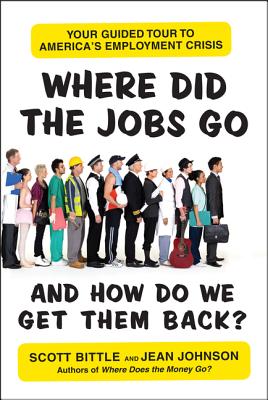Where Did the Jobs Go?
January 31, 2012
From the authors of Where Does the Money Go? : Your Guided Tour to the Federal Budget Crisis and Who Turned Out the Lights? : Your Guided Tour to the Energy Crisis, comes a new book about an issue of grave national importance that has touched most of our lives recently, and will be central to the political debate this election year.
In Where Did the Jobs Go—And How Do We Get Them Back?: Your Guided Tour to America's Employment Crisis, being released tomorrow by William Morrow & Company, Scott Bittle and Jean Johnson have provided a thoroughly researched, easy-to-read analysis of the jobs situation in America—minus the hyperbole, political posturing, and invective that's been thrown around the public debates and airwaves recently and is certain to increase in the coming months. As the authors explain in the book's preface, they wrote this book as "a guide for citizens, not offering advice for investors, entrepreneurs, or job hunters." In that sense it's not a proper business book per se, but it can help each of us see the overall jobs picture and business environment more clearly.
The situation is difficult in both its human cost and economic complexity, but Bittle and Johnson try to keep the mood light, cleverly peppering in anecdotes from popular culture sources such as TV shows Friends and Seinfeld, the 1950s movie Dragnet, the musical career of Elvis, and more to explain the economic theories and principles their book needs to address the jobs issue thoroughly. And so the book is able to tackle frightening statistics and daunting questions without losing the lay reader or terrifying the nightly news watcher. They're also able to look at these issues without becoming embroiled in the partisan debate that so often dominates the discussion on the cable news networks, though they don't shy away from the more complicated and complex issues. It is because the issues are complex and complicated and so rarely conform to either a conservative or liberal narrative that they're able to do so. The fundamental and hotly debated issue of whether the employment crisis is cyclical or structural, for instance, in which the business and political implications are so huge, isn't clear—or if it is, it's clearly not one-sided.
Chapters 5 through 11, the section of the book entitled "Inquiring Minds Want to Know," tackles the most contentious debate going—that of austerity versus stimulus. The authors rightly point out that stimulus has become unpopular, partly because most Americans tend to equate the word stimulus with the Troubled Asset Relief Program (or TARP) that bailed out the big banks and the auto companies. (TARP was not, in fact, part of the stimulus, but an emergency measure to recapitalize the banks in an effort to keep the crisis on Wall Street from spilling over into the larger, "real" economy. The stimulus actually included measures that are overwhelmingly popular—tax breaks, aid to state and local governments, and help for the unemployed. Conversely, cutting the deficit, or austerity, is more popular in theory but the measures it calls for—raising taxes and cutting popular programs like Social Security and Medicare—are wildly unpopular.)
The comments in parentheses above are my own. The authors don't delve too deeply into political opinion, but stick instead to Dragnet Joe Friday's "just the fact ma'am" approach. In the "Inquiring Minds Want to Know Section," they ask seven questions: Would Balancing the Budget Create Jobs?; Would Cutting Taxes Help Create Jobs?; Would Cutting Bureaucracy Help Create Jobs?; Would Reviving Manufacturing Help Create Jobs?; Would Improving Education Help Create Jobs?; Would a Major Infrastructure Project Help Create Jobs? and; Would Closing the Gap Between Rich and Poor Help Create Jobs? You may think you know the "facts ma'am" answers to most of these questions. I know I did, and I know I was surprised by some of them and conclusions I came to afterward.
The book then moves on to the larger and longer-term effects of globalization, technology, immigration, and the aging of the baby-boomers. And sticking to it's nonpartisan approach, the "Fourteen Big Ideas for Creating More and Better Jobs" at the end of the book are all over the partisan map, including everything from rolling back environmental regulations to keep energy costs low to supporting the union movement and getting business out of the health insurance business.
There was a really great book by Nicholas Wapshott put out late last year by W.W. Norton & Company entitled Keynes Hayek: The Clash That Defined Modern Economics (I plan on reviewing it here soon). In it, Wapshott details how the economic debate between intervention and unfettered markets that has become so rancorous in this country and around the Western world began. Where Did the Jobs Go—And How Do We Get Them Back?: Your Guided Tour to America's Employment Crisis details how the various sides of that debate could conceivably find a compromise, at least in the near term and with regards to the single issue of job creation.


